Spatio-Temporal Evolution and Future Simulation of Agricultural Land Use in Xiangxi, Central China
Abstract
:1. Introduction
- The overall change pattern of agricultural land from 2000 to 2018 in Xiangxi is identified by spatial analysis methods.
- The change characteristics of each agricultural land are detected using GIS techniques in the study area during the same study period.
- The future scenarios of agricultural land use in 2030 are simulated by gray forecasting model and GeoSoS-FLUS model.
2. Data and Methods
2.1. Study Area
2.2. Datasets and Their Preprocessing
2.3. Research Methods
2.3.1. Agricultural Land Classification System Is Constructed
2.3.2. Agricultural Land Use Change Is Assessed
2.3.3. Future Scenario of Agricultural Land Use Is Simulated
- (1)
- Gray forecasting model
- (2)
- GeoSoS-FLUS model
3. Results and Analysis
3.1. Overall Characteristics of Agricultural Land Use Change
3.1.1. More Than Half of Total Extent Is Agricultural Land, While the Extent of Which Has Decreased
3.1.2. The Change of Arable Land and Fishery Land Was the Most Prominent
3.2. Characteristics of Each Agricultural Land Use Change
3.2.1. The Density of Each Agricultural Land Had Strong Spatial Heterogeneity and Changed Slightly
3.2.2. Main Change Trend Was Loss, and Change Had Spatial Heterogeneity
3.3. The Future Scenario of Agricultural Land Use in Xiangxi
4. Conclusions and Discussion
4.1. Conclusions
4.2. Discussion
4.2.1. Implications for Agricultural Land Use
4.2.2. Contribution of This Study
4.2.3. Research Prospect
Author Contributions
Funding
Data Availability Statement
Acknowledgments
Conflicts of Interest
References
- Xiang, H.; Wang, Y.H.; Huang, Q.Q.; Yang, Q.Y. How Much Is the Eco-Efficiency of Agricultural Production in West China? Evidence from the Village Level Data. Int. J. Environ. Res. Public Health 2020, 17, 4049. [Google Scholar] [CrossRef] [PubMed]
- Lambin, E.F.; Rounsevell, D.M.; Geist, H.J. Are agricultural land-use models able to predict changes in land-use intensity? Agric. Ecosyst. Environ. 2000, 82, 321–331. [Google Scholar] [CrossRef]
- Thapa, G.B.; Yila, O.M. Farmers’ land management practices and status of agricultural land in the Jos Plateau, Nigeria. Land Degrad. Dev. 2012, 23, 263–277. [Google Scholar] [CrossRef]
- Boateng, P.; Appiah, D.; Adjei, P.; Mensah, H. Perceptions of Socio-Ecological Changes and Their Implications on Changes in Farming Practises and Agricultural Land Uses in the Savannahs of Northeast Ghana. Environments 2016, 3, 33. [Google Scholar] [CrossRef] [Green Version]
- Mottet, A.; Ladet, S.; Coqué, N.; Gibon, A. Agricultural land-use change and its drivers in mountain landscapes: A case study in the Pyrenees. Agric. Ecosyst. Environ. 2006, 114, 296–310. [Google Scholar] [CrossRef]
- Kazungu, M.; Ferrer Velasco, R.; Zhunusova, E.; Lippe, M.; Kabwe, G.; Gumbo, D.J.; Günter, S. Effects of household-level attributes and agricultural land-use on deforestation patterns along a forest transition gradient in the Miombo landscapes, Zambia. Ecol. Econ. 2021, 186, 107070. [Google Scholar] [CrossRef]
- Razali, A.; Ismail, S.N.S.; Awang, S.; Praveena, S.M.; Abidin, E.Z. Land use change in highland area and its impact on river water quality: A review of case studies in Malaysia. Ecol. Processes 2018, 7, 1–19. [Google Scholar] [CrossRef] [Green Version]
- Mosammam, H.M.; Nia, J.T.; Khani, H.; Teymouri, A.; Kazemi, M. Monitoring land use change and measuring urban sprawl based on its spatial forms: The case of Qom city. Egypt. J. Remote Sens. Space Sci. 2017, 20, 103–116. [Google Scholar]
- Kc, B.; Race, D. Outmigration and land-use change: A case study from the middle hills of Nepal. Land 2020, 9, 2. [Google Scholar] [CrossRef] [Green Version]
- Di Febbraro, M.; Menchetti, M.; Russo, D.; Ancillotto, L.; Aloise, G.; Roscioni, F.; Preatoni, D.G.; Loy, A.; Martinoli, A.; Bertolino, S. Integrating climate and land-use change scenarios in modelling the future spread of invasive squirrels in Italy. Divers. Distrib. 2019, 25, 644–659. [Google Scholar] [CrossRef] [Green Version]
- Fu, X.; Wang, X.; Yang, Y.J. Deriving suitability factors for CA-Markov land use simulation model based on local historical data. J. Environ. Manag. 2018, 206, 10–19. [Google Scholar] [CrossRef] [PubMed]
- Firozjaei, M.K.; Sedighi, A.; Argany, M.; Jelokhani-Niaraki, M.; Arsanjani, J.J. A geographical direction-based approach for capturing the local variation of urban expansion in the application of CA-Markov model. Cities 2019, 93, 120–135. [Google Scholar] [CrossRef]
- Wang, Y.; Shen, J.; Yan, W.; Chen, C. Backcasting approach with multi-scenario simulation for assessing effects of land use policy using GeoSOS-FLUS software. MethodsX 2019, 6, 1384–1397. [Google Scholar] [CrossRef] [PubMed]
- Lin, W.; Sun, Y.; Nijhuis, S.; Wang, Z. Scenario-based flood risk assessment for urbanizing deltas using future land-use simulation (FLUS): Guangzhou Metropolitan Area as a case study. Sci. Total Environ. 2020, 739, 139899. [Google Scholar] [CrossRef]
- Dadashpoor, H.; Azizi, P.; Moghadasi, M. Land use change, urbanization, and change in landscape pattern in a metropolitan area. Sci. Total Environ. 2019, 655, 707–719. [Google Scholar] [CrossRef] [PubMed]
- Hurtt, G.C.; Chini, L.; Sahajpal, R.; Frolking, S.; Bodirsky, B.L.; Calvin, K.; Doelman, J.C.; Fisk, J.; Fujimori, S.; Klein Goldewijk, K. Harmonization of global land use change and management for the period 850–2100 (LUH2) for CMIP6. Geosci. Model Dev. 2020, 13, 5425–5464. [Google Scholar] [CrossRef]
- Rogger, M.; Agnoletti, M.; Alaoui, A.; Bathurst, J.; Bodner, G.; Borga, M.; Chaplot, V.; Gallart, F.; Glatzel, G.; Hall, J. Land use change impacts on floods at the catchment scale: Challenges and opportunities for future research. Water Resour. Res. 2017, 53, 5209–5219. [Google Scholar] [CrossRef] [Green Version]
- Santikari, V.P.; Murdoch, L.C. Effects of construction-related land use change on streamflow and sediment yield. J. Environ. Manag. 2019, 252, 109605. [Google Scholar] [CrossRef]
- Wang, X.; Xiao, F.; Zhang, Y.; Yin, L.; Lesi, M.; Guo, B.; Zhao, Y.; Li, R. Thirty-year expansion of construction land in Xi’an: Spatial pattern and potential driving factors. Geol. J. 2017, 53, 309–321. [Google Scholar] [CrossRef]
- Guo, L.; Di, L.; Tian, Q. Detecting spatio-temporal changes of arable land and construction land in the Beijing-Tianjin corridor during 2000–2015. J. Geogr. Sci. 2019, 29, 702–718. [Google Scholar] [CrossRef] [Green Version]
- Alijani, Z.; Hosseinali, F.; Biswas, A. Spatio-temporal evolution of agricultural land use change drivers: A case study from Chalous region, Iran. J. Environ. Manag. 2020, 262, 110326. [Google Scholar] [CrossRef] [PubMed]
- Cardille, J.A.; Foley, J.A. Agricultural land-use change in Brazilian Amazonia between 1980 and 1995: Evidence from integrated satellite and census data. Remote Sens. Environ. 2003, 87, 551–562. [Google Scholar] [CrossRef]
- Xiang, H.; Yang, Q.Y.; Su, K.C.; Zhang, Z.X.J.A.S. Spatiotemporal Dynamics and Obstacles of the Multi-Functionality of Land Use in Xiangxi, China. Appl. Sci. 2019, 9, 3649. [Google Scholar] [CrossRef] [Green Version]
- Baessler, C.; Klotz, S. Effects of changes in agricultural land-use on landscape structure and arable weed vegetation over the last 50 years. Agric. Ecosyst. Environ. 2006, 115, 43–50. [Google Scholar] [CrossRef]
- Souza, C.M.; Shimbo, J.Z.; Rosa, M.R.; Parente, L.L.; Azevedo, T. Reconstructing Three Decades of Land Use and Land Cover Changes in Brazilian Biomes with Landsat Archive and Earth Engine. Remote Sens. 2020, 12, 2735. [Google Scholar] [CrossRef]
- Sohl, T.L.; Wimberly, M.C.; Radeloff, V.C.; Theobald, D.M.; Sleeter, B.M. Divergent projections of future land use in the United States arising from different models and scenarios. Ecol. Model. 2016, 337, 281–297. [Google Scholar] [CrossRef] [Green Version]
- Satya, B.A.; Shashi, M.; Deva, P. Future land use land cover scenario simulation using open source GIS for the city of Warangal, Telangana, India. Appl. Geomat. 2020, 12, 281–290. [Google Scholar] [CrossRef]
- Homer, C.; Dewitz, J.; Jin, S.; Xian, G.; Costello, C.; Danielson, P.; Gass, L.; Funk, M.; Wickham, J.; Stehman, S.; et al. Conterminous United States land cover change patterns 2001–2016 from the 2016 National Land Cover Database. ISPRS J. Photogramm. Remote Sens. 2020, 162, 184–199. [Google Scholar] [CrossRef]
- Chen, Y.C. A tutorial on kernel density estimation and recent advances. Biostat. Epidemiol. 2017, 1, 161–187. [Google Scholar] [CrossRef]
- He, Y.; Li, H. Probability density forecasting of wind power using quantile regression neural network and kernel density estimation. Energy Convers. Manag. 2018, 164, 374–384. [Google Scholar] [CrossRef]
- Hu, Y.; Wang, F.; Guin, C.; Zhu, H. A spatio-temporal kernel density estimation framework for predictive crime hotspot mapping and evaluation. Appl. Geogr. 2018, 99, 89–97. [Google Scholar] [CrossRef]
- Spencer, C.; Yakymchuk, C.; Ghaznavi, M. Visualising data distributions with kernel density estimation and reduced chi-squared statistic. Geosci. Front. 2017, 8, 1247–1252. [Google Scholar] [CrossRef]
- Ding, S.; Li, R. Forecasting the sales and stock of electric vehicles using a novel self-adaptive optimized grey model. Eng. Appl. Artif. Intell. 2021, 100, 104148. [Google Scholar] [CrossRef]
- Zhou, T.; Hu, Z.; Zhou, Q.; Yuan, S. A novel grey prediction evolution algorithm for multimodal multiobjective optimization. Eng. Appl. Artif. Intell. 2021, 100, 104173. [Google Scholar] [CrossRef]
- Sun, Q.; Wei, Q.; Xu, X. Impacts of land use change on ecosystem services in the intensive agricultural area of North China based on Multi-scenario analysis. Alex. Eng. J. 2020, 8, 1703–1716. [Google Scholar] [CrossRef]
- Butet, A.; Michel, N.; Rantier, Y.; Comor, V.; Hubertmoy, L.; Nabucet, J.; Delettre, Y.R. Responses of common buzzard (Buteo buteo) and Eurasian kestrel (Falco tinnunculus) to land use changes in agricultural landscapes of Western France. Agric. Ecosyst. Environ. 2010, 3, 152–159. [Google Scholar] [CrossRef]
- Mcintyre, S.C. Reservoir sedimentation rates linked to long-term changes in agricultural land use. Jawra J. Am. Water Resour. Assoc. 2010, 29, 487–495. [Google Scholar] [CrossRef]
- Debolini, M.; Schoorl, J.M.; Temme, A.; Galli, M.; Bonari, E. Changes in Agricultural Land Use Affecting Future Soil Redistribution Patterns: A Case Study in Southern Tuscany (Italy). Land Degrad. Dev. 2015, 26, 574–586. [Google Scholar] [CrossRef]
- He, J.; Shi, X.; Fu, Y.; Yuan, Y. Evaluation and simulation of the impact of land use change on ecosystem services trade-offs in ecological restoration areas, China. Land Use Policy 2020, 99, 105020. [Google Scholar] [CrossRef]
- Liu, M.L.; Tian, H.Q. China’s land cover and land use change from 1700 to 2005: Estimations from high-resolution satellite data and historical archives RID B-1361–2009. Glob. Biogeochem. Cycles 2010, 24, 1–18. [Google Scholar]
- Jia, N.; Liu, J.; Kuang, W.; Xu, X.; Jing, N. Spatiotemporal patterns and characteristics of land-use change in China during 2010–2015. J. Geogr. Sci. 2018, 28, 547–562. [Google Scholar]
- Yang, T.; Guan, X.; Qian, S.; Xing, W.; Wu, H. Efficiency Evaluation of Urban Road Transport and Land Use in Hunan Province of China Based on Hybrid Data Envelopment Analysis (DEA) Models. Sustainability 2019, 11, 3826. [Google Scholar] [CrossRef] [Green Version]
- Zhang, H.; Zeng, Y.; Jin, X.; Shu, B.; Zhou, Y.; Yang, X. Simulating multi-objective land use optimization allocation using Multi-agent system—A case study in Changsha, China. Ecol. Model. 2016, 320, 334–347. [Google Scholar] [CrossRef]
- Li, Y.; He, C. Scenario simulation and forecast of land use/cover in northern China. Chin. Sci. Bull. 2008, 53, 1401–1412. [Google Scholar] [CrossRef] [Green Version]
- Hong, W.; Li, X.; Long, H.; Qiao, Y.; Ying, L. Development and application of a simulation model for changes in land-use patterns under drought scenarios. Comput. Geosci. 2011, 37, 831–843. [Google Scholar]
- Sulistyawati, E.; Noble, I.R.; Roderick, M.L. A simulation model to study land use strategies in swidden agriculture systems. Agric. Syst. 2005, 85, 271–288. [Google Scholar] [CrossRef]
- Chen, Z.; Tang, J.; Wan, J.; Chen, Y. Promotion incentives for local officials and the expansion of urban construction land in China: Using the Yangtze River Delta as a case study. Land Use Policy 2017, 63, 214–225. [Google Scholar] [CrossRef]
- Kontokosta, C.E. Tall Buildings and Urban Expansion: Tracing the Evolution of Zoning in the United States. Leadersh. Manag. Eng. 2013, 13, 190–198. [Google Scholar] [CrossRef]
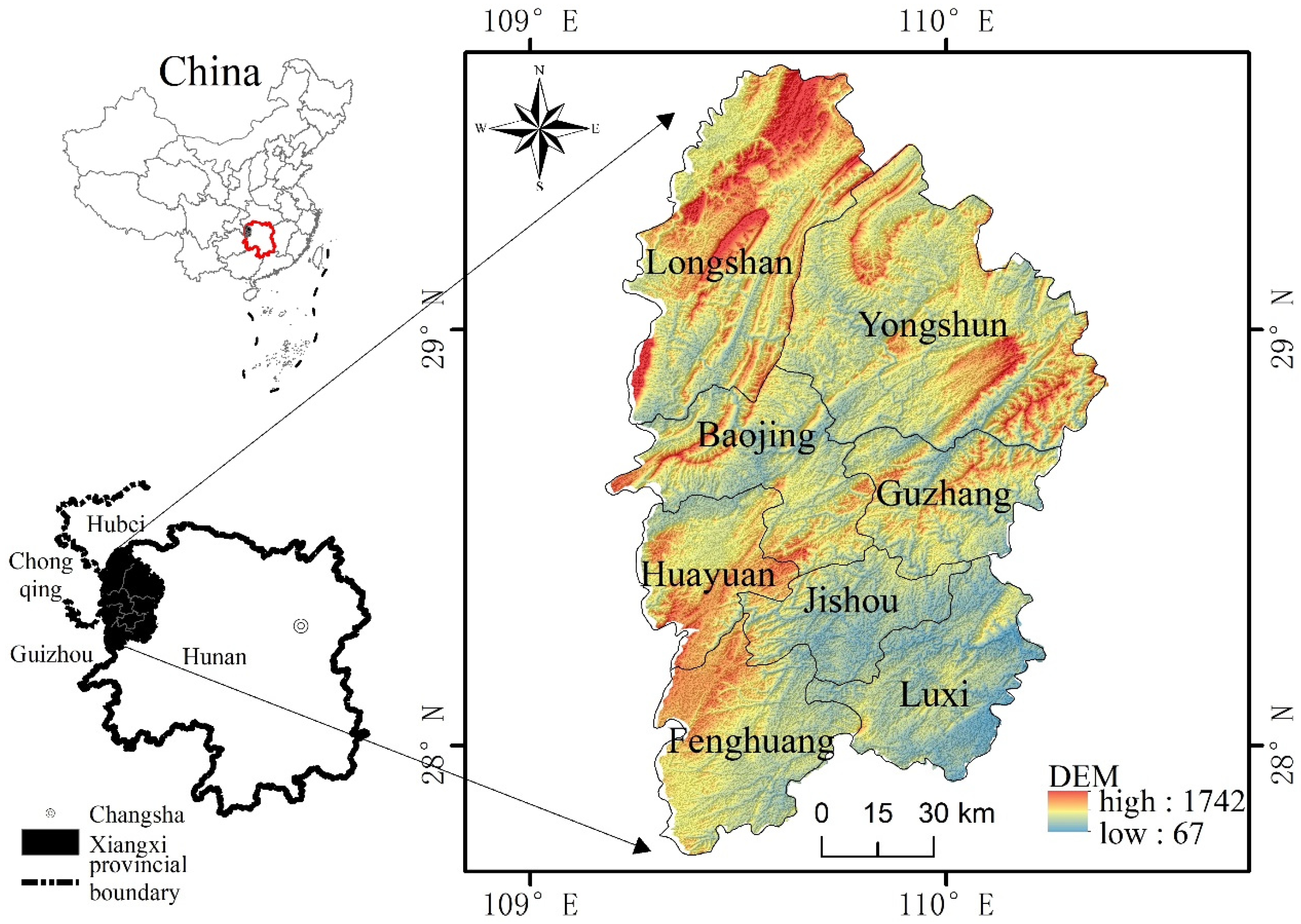
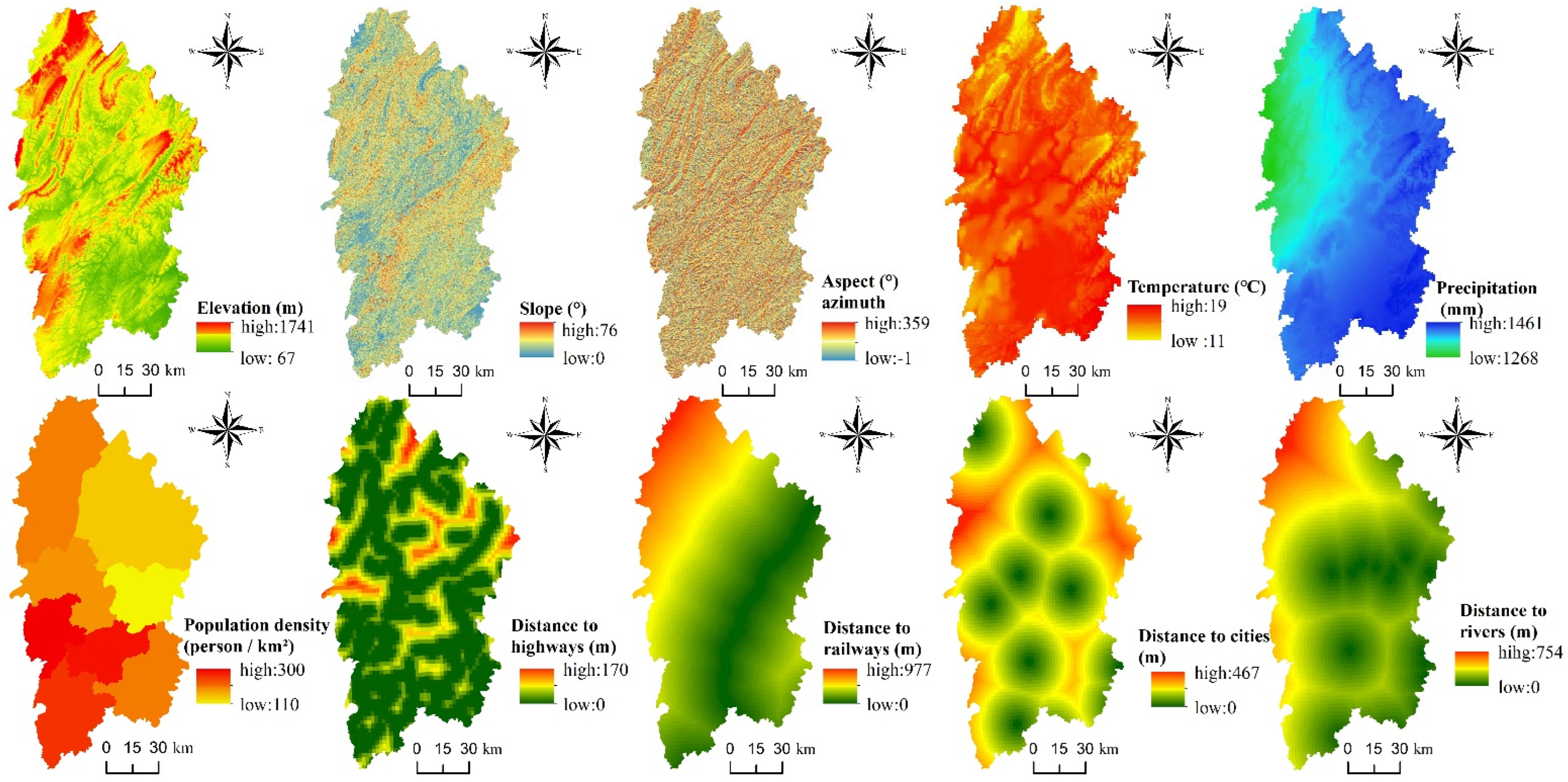
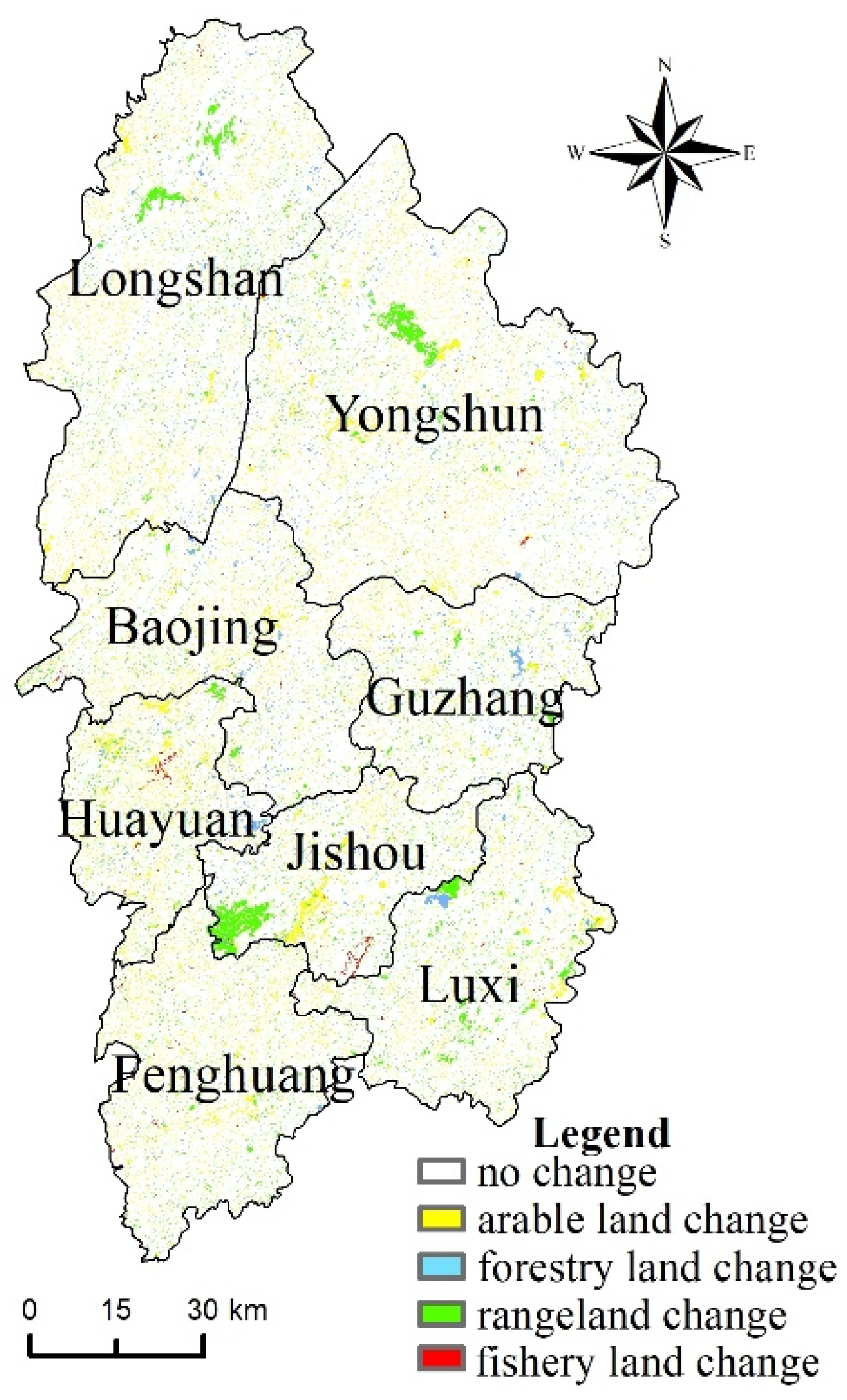
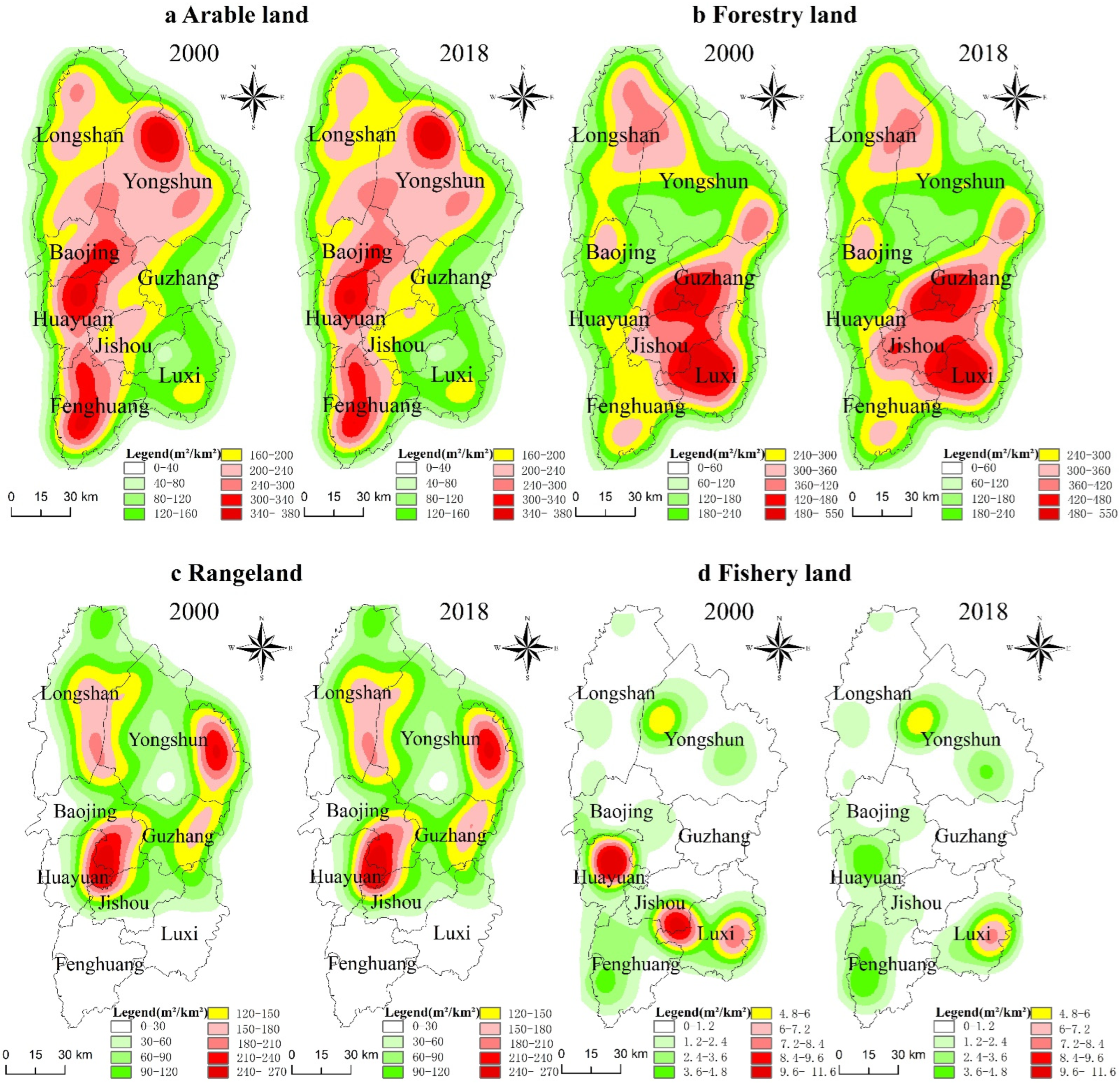
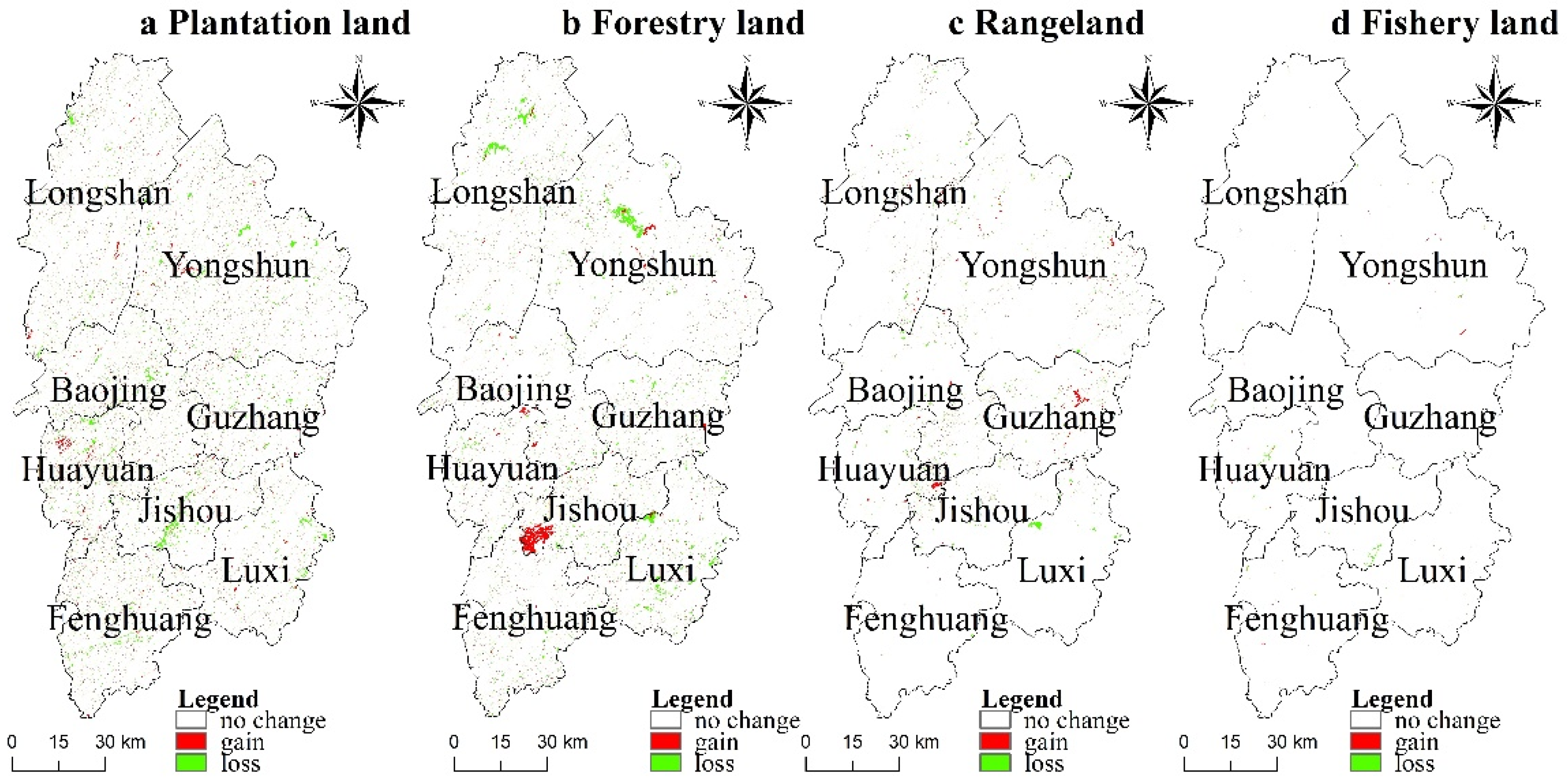
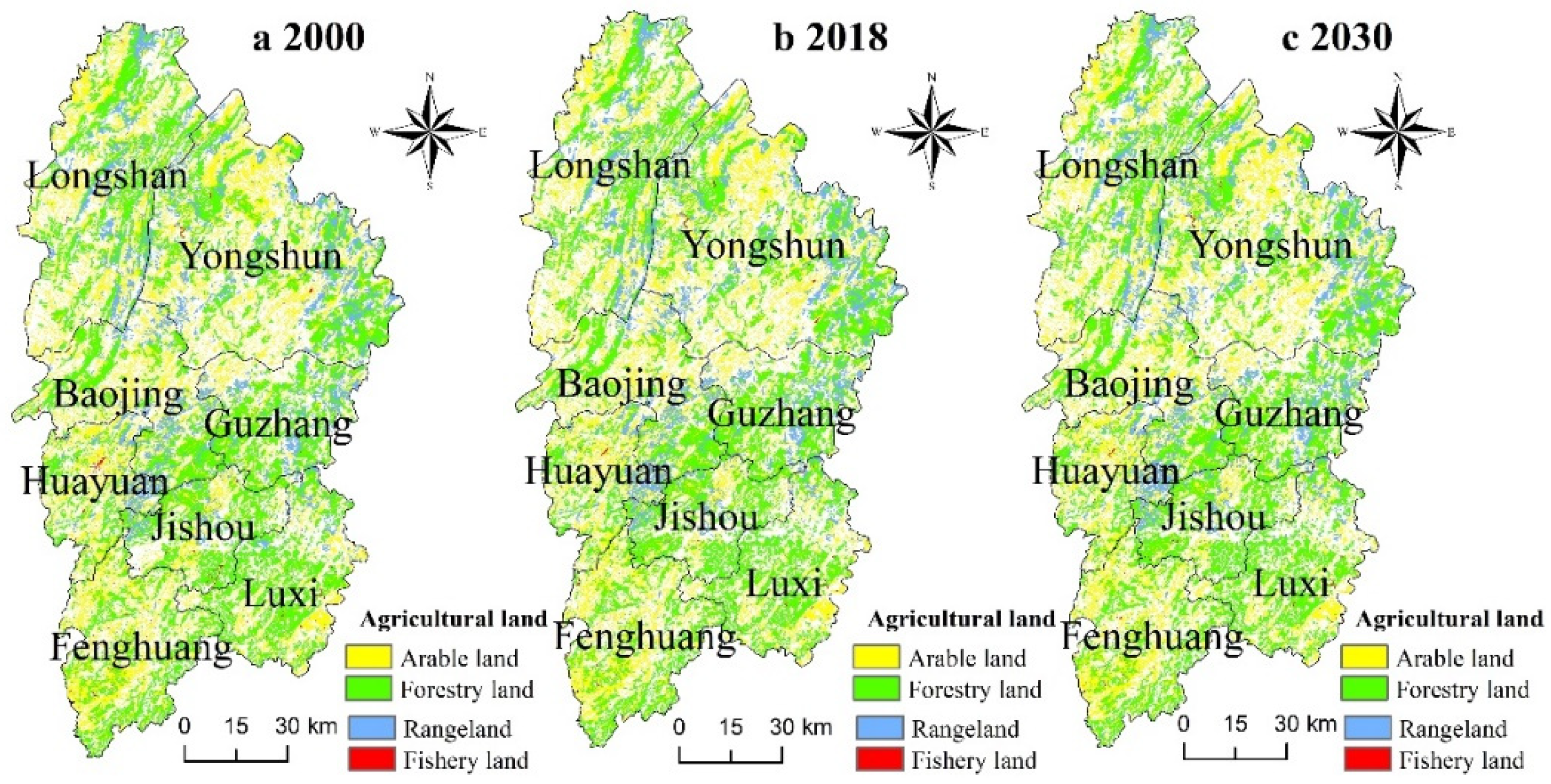
| Class | Code and Name | Description | Basis for Classification |
|---|---|---|---|
| agricultural land | 1—arable land | paddy field; dry land | paddy field and dry land are the main farming sites and belong to arable land |
| 2—forestry land | timber forest; economic forest; etc. | timber forest, economic forests, etc., are the main land for forestry production | |
| 3—rangeland | high, medium, low coverage grassland | grassland is divided into high, medium, and low coverage grassland, which is the main grazing place | |
| 4—fishery land | reservoirs and ponds | reservoirs and ponds are the main fishery place in mountainous areas |
| Data Categories | Data Name | Year | Unit | Reference |
|---|---|---|---|---|
| natural factors | elevation | m | [37] | |
| slope | ° | [37,38] | ||
| aspect | ° | [37] | ||
| temperature | 2018 | °C | [37] | |
| precipitation | 2018 | mm | [38] | |
| human factors | population density | 2018 | person/km2 | [37] |
| distance to highways | 2018 | m | [37,38] | |
| distance to railways | 2018 | m | [37] | |
| distance to the cities | 2018 | m | [37,38] | |
| distance to rivers | 2018 | m | [37,38] |
| Category | Arable Land | Forestry Land | Rangeland | Fishery Land | Total |
|---|---|---|---|---|---|
| 2000 | 2990.99 | 4193.75 | 1239.42 | 30.81 | 8454.98 |
| 2018 | 2925.80 | 4142.95 | 1232.24 | 22.72 | 8323.72 |
| Mean | 2958.40 | 4168.35 | 1235.83 | 26.77 | 8389.35 |
| net change, 2000–2018 | −65.19 | −50.80 | −7.18 | −8.09 | −131.26 |
| % of 2018 | 35.15 | 49.77 | 14.81 | 0.27 | 100 |
| Change of 2000–2018 | No Change | Arable Land Change | Forestry Land Change | Rangeland Change | Fishery Land Change |
|---|---|---|---|---|---|
| Area (km2) | 7775.03 | 495.65 | 401.89 | 119.07 | 17.33 |
| % of agricultural land | 88.26 | 5.63 | 4.56 | 1.35 | 0.20 |
| % of change | 47.93 | 38.87 | 11.52 | 1.68 | |
| Cimpor (%) | 49.36 | 38.88 | 5.64 | 6.12 | |
| Na (%) | −2.18 | −1.22 | −0.60 | −26.27 | |
| Kd (%) | 0.77 | 0.61 | 0.09 | 0.10 |
| Arable Land | ||||||
|---|---|---|---|---|---|---|
| Name | Gain (km2) | Loss (km2) | Net Change (km2) | Cimpor (%) | Na (%) | Kd (%) |
| Yongshun | 62.95 | 75.17 | −12.22 | 17.53 | −1.43 | 0.38 |
| Baojing | 33.22 | 40.51 | −7.29 | 10.76 | −1.98 | 0.23 |
| Huayuan | 34.28 | 37.18 | −2.90 | 4.40 | −1.06 | 0.10 |
| Jishou | 17.37 | 37.91 | −20.54 | 29.89 | −11.96 | 0.65 |
| Guzhang | 20.44 | 26.40 | −5.96 | 8.59 | −3.31 | 0.19 |
| Luxi | 23.61 | 31.40 | −7.79 | 11.21 | −3.14 | 0.24 |
| Longshan | 46.06 | 49.03 | −2.97 | 4.40 | −0.49 | 0.10 |
| Fenghuang | 31.09 | 40.09 | −9.01 | 13.23 | −2.05 | 0.29 |
| Forestry land | ||||||
| Name | Gain (km2) | Loss (km2) | Net change (km2) | Cimpor (%) | Na (%) | Kd (%) |
| Yongshun | 34.92 | 66.33 | −31.41 | 23.01 | −3.51 | 0.71 |
| Baojing | 19.45 | 19.73 | −0.28 | 0.19 | −0.06 | 0.01 |
| Huayuan | 16.54 | 16.38 | 0.16 | 0.02 | 0.01 | 0.00 |
| Jishou | 60.70 | 19.52 | 41.18 | 30.17 | 10.27 | 0.93 |
| Guzhang | 17.22 | 23.18 | −5.96 | 4.33 | −1.26 | 0.13 |
| Luxi | 20.40 | 48.38 | −27.98 | 20.46 | −4.54 | 0.63 |
| Longshan | 27.72 | 54.90 | −27.18 | 20.03 | −3.35 | 0.62 |
| Fenghuang | 24.13 | 26.58 | −2.45 | 1.78 | −0.47 | 0.05 |
| Rangeland | ||||||
| Name | Gain (km2) | Loss (km2) | Net change (km2) | Cimpor (%) | Na (%) | Kd (%) |
| Yongshun | 24.14 | 22.28 | 1.87 | 6.24 | 0.39 | 0.13 |
| Baojing | 9.39 | 12.75 | −3.36 | 12.99 | −2.19 | 0.27 |
| Huayuan | 10.70 | 8.07 | 2.63 | 9.76 | 2.33 | 0.20 |
| Jishou | 5.33 | 7.77 | −2.44 | 9.34 | −3.01 | 0.19 |
| Guzhang | 16.57 | 11.37 | 5.20 | 19.40 | 3.11 | 0.40 |
| Luxi | 2.23 | 10.55 | −8.32 | 30.79 | −16.79 | 0.64 |
| Longshan | 12.27 | 14.89 | −2.62 | 9.83 | −0.93 | 0.20 |
| Fenghuang | 0.42 | 0.86 | −0.44 | 1.65 | −6.93 | 0.03 |
| Fishery land | ||||||
| Name | Gain (km2) | Loss (km2) | Net change (km2) | Cimpor (%) | Na (%) | Kd (%) |
| Yongshun | 2.23 | 2.08 | 0.15 | 1.50 | 2.19 | 0.41 |
| Baojing | 0.51 | 1.25 | −0.74 | 7.97 | −28.04 | 2.16 |
| Huayuan | 0.86 | 3.90 | −3.04 | 34.35 | −53.55 | 9.30 |
| Jishou | 0.29 | 3.66 | −3.38 | 39.11 | −72.97 | 10.59 |
| Guzhang | 0.08 | 0.45 | −0.37 | 4.02 | −55.60 | 1.09 |
| Luxi | 0.76 | 1.63 | −0.88 | 10.02 | −13.85 | 2.71 |
| Longshan | 0.46 | 0.74 | −0.28 | 2.96 | −10.80 | 0.80 |
| Fenghuang | 1.30 | 1.31 | −0.01 | 0.07 | −0.15 | 0.02 |
| Agricultural Land | Arable Land | Forestry Land | Rangeland | Fishery Land | Total |
|---|---|---|---|---|---|
| area (km2) | 2877.52 | 4104.28 | 1216.37 | 15.47 | 8213.65 |
| proportion (%) | 35.03 | 49.97 | 14.81 | 0.19 | 100 |
| net change (km2) | −113.47 | −89.47 | −23.05 | −15.34 | −241.34 |
| change rate (%) | −3.79 | −2.13 | −1.86 | −49.78 | −2.85 |
Publisher’s Note: MDPI stays neutral with regard to jurisdictional claims in published maps and institutional affiliations. |
© 2022 by the authors. Licensee MDPI, Basel, Switzerland. This article is an open access article distributed under the terms and conditions of the Creative Commons Attribution (CC BY) license (https://creativecommons.org/licenses/by/4.0/).
Share and Cite
Xiang, H.; Ma, Y.; Zhang, R.; Chen, H.; Yang, Q. Spatio-Temporal Evolution and Future Simulation of Agricultural Land Use in Xiangxi, Central China. Land 2022, 11, 587. https://doi.org/10.3390/land11040587
Xiang H, Ma Y, Zhang R, Chen H, Yang Q. Spatio-Temporal Evolution and Future Simulation of Agricultural Land Use in Xiangxi, Central China. Land. 2022; 11(4):587. https://doi.org/10.3390/land11040587
Chicago/Turabian StyleXiang, Hui, Yinhua Ma, Rongrong Zhang, Hongji Chen, and Qingyuan Yang. 2022. "Spatio-Temporal Evolution and Future Simulation of Agricultural Land Use in Xiangxi, Central China" Land 11, no. 4: 587. https://doi.org/10.3390/land11040587
APA StyleXiang, H., Ma, Y., Zhang, R., Chen, H., & Yang, Q. (2022). Spatio-Temporal Evolution and Future Simulation of Agricultural Land Use in Xiangxi, Central China. Land, 11(4), 587. https://doi.org/10.3390/land11040587







